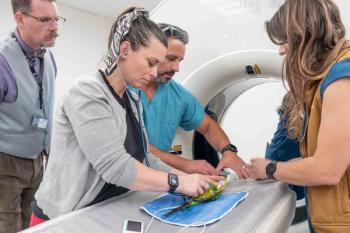
Emergency imaging of dyspneic cats (Proceedings)
Often our most delicate patients, dyspneic cats demand the utmost efficiency with the minimal stress during imaging. While most radiologist would appreciate 2 or 3 view imaging, the practical clinician will attempt to maximize the stress inherent in radiography with a single view.
Often our most delicate patients, dyspneic cats demand the utmost efficiency with the minimal stress during imaging. While most radiologist would appreciate 2 or 3 view imaging, the practical clinician will attempt to maximize the stress inherent in radiography with a single view. This session will discuss views, differential diagnoses and "clinical pearls" on radiology of dyspneic cats.
Principles of localization
Reading radiographs accurately requires a method. One method is to quickly review the entire image looking for a recognizable lesion. This "Aunt Minnie" technique serves us so well in so many cases, we are apt to err in using this method to the exclusion of a more complete method. Any method that provides a complete evaluation of all structures is OK with me. I may start with an Aunt Minnie approach but invariably complete the interpretation with a systematic approach.
Emergency radiography
Don't kill the cat! Make it quick and as stress free as absolutely possible. Along these lines make sure to measure the cat in its cage. Place the cassette on the tabletop (if you are still analog!), set the technique on you machine and put on your lead all before removing the stressed patient from their little temporary home. Limit your views to those that the cat will temporarily allow, starting with a lateral, up to a lateral of the neck region as clinically indicated. A four-view series is often necessary to sort through all potential underlying regions.
Where is the problem?
The most important interpretation may be to isolate the primary lesion site. Is the disease pleural? Pneumothorax and pleural free fluid must be diagnosed early and confidently to speed definitive therapy. The next most important decision tree branch is; heart or lung? This can often be quite difficult. Concurrent lesions may prevent complete assessment of the cardiac silhouette and therefore our ability to assess cardiomegaly. Often I would perform an quick echocardiogram rather than perform an elaborate radiographic series or consider post-therapy radiographs just for speed of reaching the final diagnosis. Similarly, primary mediastinal diseases warrant an ultrasound examination early in the process for concurrent fine needle aspiration of the causative mass lesion.
Lung lesions
Let's say that the cat has no pleural or mediastinal disease and obvious increased lung opacity. This is where we use the pattern approach for lung lesion characterization. The twist is that the rules differ from basic dog rules. Most important is the rule of cardiogenic pulmonary edema being predominantly perihilar. In cats it may be perihilar or just as likely ventral, multifocal or solitary. In other words, it is a difficult diagnosis to confidently rule-out until echocardiography is supportive. However concurrent clinical signs, such as a murmur, hypothermia, thrombosis, and radiographic cardiomegaly (next section) are very supportive.
Pneumonia looks like pneumonia, except when we consider atypical locally prevalent causes, such as mycoplasmosis, toxoplasmosis, histoplasmosis, and blastomycosis amongst others. Primary lung neoplasia may be a large solitary mass, a la dog, but more commonly appears as a nonconsolidating alveolar pattern. These lesions can be focal or multifocal, unilateral or bilateral, and can overlap quite readily for the patterns seen with cardiogenic edema an atypical pneumonia.
Finally, how can a discussion of the dyspneic cat be complete without a review of asthma? The two classic manifestations are the hyperlucent, hyperinflated appearance associated with the acute phase and the bronchial pattern seen in the more chronic phase. However, a normal appearing thorax is still a viable manifestation of a severely asthmatic cat. In fact asthma (or the latest "in vogue" term/acronym) is the primary rule-out for a severely dyspneic cat with a normal-appearing thorax. As a consideration, remember that infections, such as mycoplasmosis, can have a substantial immune component to the chronic bronchitis. Mineralization is seen with primary lung neoplasia and atypical pneumonia, but not with edema.
Cardiomegaly
Cat hearts are much more difficult to interpret than dogs. The rules of "% of the width of the chest" or "# of intercostal spaces" is extremely dependent on body condition, phase of respiration, ability to deeply inspire and concurrent medical conditions. With obesity so very common in our feline patients, a heart filling the chest may be more a manifestation of obesity than cardiomegaly. Two tools seem relevant after we discount other more variable criteria; 1) shape of the caudal heart base on the lateral projection and, 2) vertebral heart scale on the VD view. On both projections the normal cat heart is "almond" shaped. With left atrial enlargement, the caudal heart base becomes concave, instead of convex. This appearance is likened to the normal curved contour of the kidney (reniform!?). On the VD view the normal heart is less than 4 vertebrae wide. While this is not very sensitive, it is highly specific. The caution at this point bring us back to the obese cat. Cats deposit fat adjacent to the heart, which widens the heart on the VD view and, while of a disparate density, causes border effacement with the heart.
Conclusions
Be gentle, quick and efficient. Where is the lesion? How big is the heart? Primary lung or secondary to heart? Don't forget asthma.
References
King LG. Respiratory Disease in Dogs and Cats. St. Louis, MO: WB Saunders; 2004; 665pp.
O'Brien RT. Thoracic Radiology for the Small Animal Practitioner. Jackson, WY: Teton New Media; 2001;
Litster AL, Buchanan JW. Vertebral scale system to measure heart size in radiographs of cats. J Am Vet Med Assoc 2000 Jan 15;216(2):210-4.
Litster AL, Buchanan JW. Radiographic and echocardiographic measurement of the heart in obese cats. Vet Radiol Ultrasound 2000 Jul-Aug;41(4):320-5.
Newsletter
From exam room tips to practice management insights, get trusted veterinary news delivered straight to your inbox—subscribe to dvm360.






